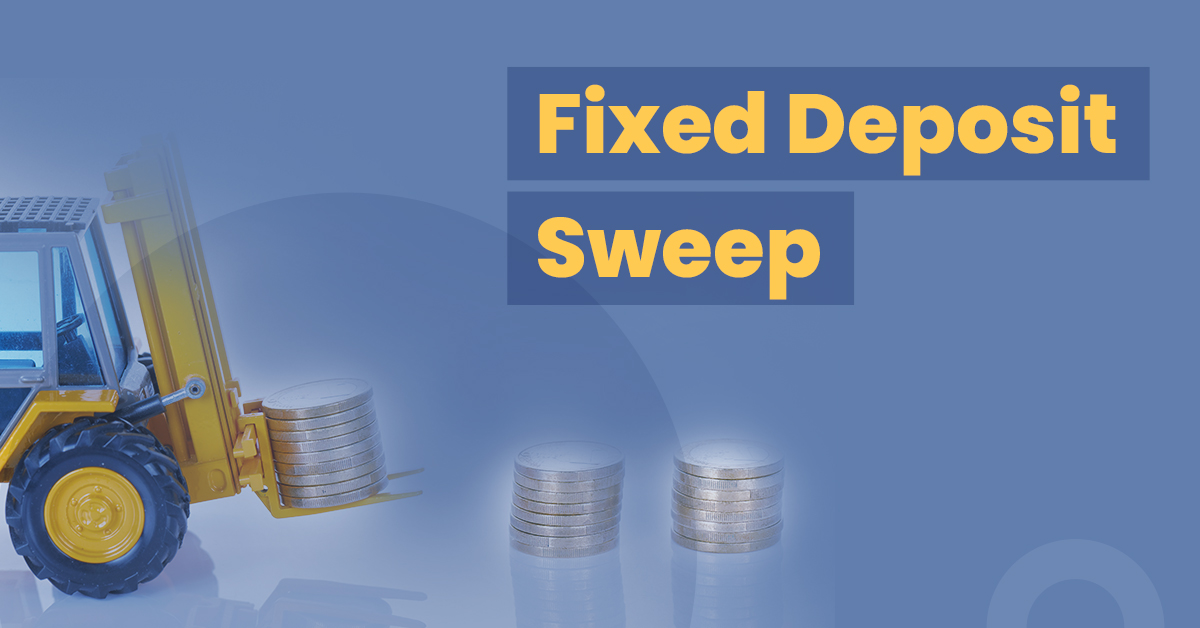What is Sweep-in FD (Fixed Deposit)? Meaning, Interest Rate, Benefits


A traditional investment instrument, Fixed Deposits offer assured returns over a fixed term. However, the catch is that the amount you deposited in an FD gets locked for the entire term. Even if you need to withdraw a part of the amount before the FD matures, you will be charged a penalty and might lose out on the interest income for the entire amount. Therefore, if you need to maintain a certain degree of flexibility over your FD, you can opt to invest in a sweep-in FD.
Such linked FDs allow you to enjoy the interest rates of a regular FD with the flexibility and liquidity features of saving accounts. Curious to know more? Keep reading to learn about fixed deposit sweep-in meaning, how it works, interest rates, features, benefits and disadvantages. We have also mentioned the difference between sweep-in and sweep-out fixed deposits.
What is Fixed Deposit Sweep-in?
A fixed deposit sweep-in is a type of fixed deposit where a savings or a current account gets linked to your FD. You have to specify a minimum balance to be retained in your savings account, and any amount beyond this is swept into the FD with no extra hassle.
Hence, a sweep-in FD allows you to earn higher interest rates on your surplus money while maintaining minimum liquidity. If you run short of funds in your savings account, you can withdraw the same from the linked FD without attracting penalties.
Features of a Sweep-in FD Facility
Let’s look at the features of a sweep-in Fixed Deposit:
Account Linking:
For the sweep-in FD facility, the investor’s current or savings account must be linked to the FD. A pre-requisite is having a bank account in the same bank where the FD is opened.
Investment Threshold:
Surplus money from savings, usually above INR 1,000, gets automatically transferred to the sweep-in FD. Some banks offer flexibility, allowing transfers between INR 1 and INR 1,000 based on investor preferences.
Duration:
The auto sweep-in FD typically has a tenure of one to five years.
Interest Benefits:
The interest rate on the sweep-in FD is comparable to standard FD rates, allowing surplus funds to earn FD-like returns instead of the typically lower savings account interest.
Eligibility Criteria:
The facility is not universal. To access the sweep-in option, an investor needs a minimum FD investment of INR 25,000 or a premium bank account with balances from INR 25,000 to INR 1,00,000.
Flexible Withdrawals:
Investors can withdraw the extra amount swept into the FD without breaking the entire deposit. This withdrawal comes without penalties or fees, ensuring preserved interest on the core FD amount.
Also Read: Experience financial growth with unmatched Bajaj Finance FD Rates
How Does the Sweep-in Facility Work?
You need to have a bank account in the same bank and set the cut-off amount, beyond which all else gets transferred to the FD. Now, let us understand how the Sweep-in FD facility works with an example.
For example, Let’s say your savings account balance is Rs. 35,000, and you set up a sweep-in FD with an instruction to maintain a minimum balance of Rs. 30000 in your savings account. After keeping the minimum of Rs. 30000, the remaining Rs. 5000 will be swept into the FD. Now, suppose you need to withdraw 32000 to pay rent. After deducting Rs. 30000 from your savings account, Rs. 2000 will be automatically drawn from the sweep-in FD.
How to Avail the Sweep-in Fixed Deposit Facility?
You can avail of a sweep-in facility both online and offline. For online mode, you must log in to your net banking account and link your savings/current account to your fixed deposit. Set a limit beyond which the surplus will be transferred to the FD. You will also have to select a tenure for the FD.
You can also do the same by visiting a bank branch where you wish to have your sweep-in FD.
Is there any Eligibility for a Sweep-in Account?
To be eligible for the sweep-in facility, you must invest a minimum of Rs. 25000 in the FD. Additionally, premium account holders having a balance of Rs. 25000 – Rs. 100000 are also eligible for the sweep-in facility on their FDs.
What are the Advantages & Disadvantages of Investing in a Sweep-in FD?
Let’s look at some of the advantages and disadvantages of investing in a sweep-in FD:
Benefits of Sweep-in-FDs?
Enjoy Higher Returns: The sweep-in FD combines the benefit of high FD interest rates with the liquidity of a savings account, ensuring the depositor earns more than typical savings account interest. Even when amounts are swept or withdrawn, the core FD interest remains unaffected.
Liquidity: One of the prominent advantages of a sweep-in facility is its unparalleled liquidity. Funds transition smoothly between the savings and FD accounts as needed.
Linking Multiple Accounts: A depositor has the option to connect multiple FD accounts to a single savings account, further boosting liquidity.
Customization: Banks empower depositors with choices, from selecting the FD’s tenure to deciding the desired balance in their savings or current accounts. This level of adaptability ensures depositors can tailor the facility to their unique financial situations.
Zero Extra Costs: Sweep-in FDs come without the baggage of extra fees. Unlike certain banking facilities like overdrafts, no additional charges are levied. Plus, there’s the added benefit of penalty-free premature withdrawals.
Disadvantages of a Sweep-in Fixed Deposit
Lower Overall Interest: While the interest on the swept-in amount is higher than a savings account, it might be lower than a long-term FD. If the money stays in the FD account for a shorter duration due to frequent sweeps, it might not fetch the highest possible interest.
Tax Implications: Interest earned from the FD is taxable. Depending on the interest amount and an individual’s income slab, it might result in a tax liability, whereas interest from savings accounts up to a certain limit might be exempted.
Complexity: Managing a sweep-in FD requires a bit more attention than a regular savings or FD account. For someone unfamiliar, it might be a bit overwhelming, especially when handling multiple linked accounts.
Not Always Automatic: Some banks might not offer an automatic sweep-in facility. Instead, they might require manual instructions every time, which can be tedious.
Missed Opportunities: Funds that are frequently swept into short-term FDs might miss out on better returns from other investment avenues. For investors looking for higher growth, locking funds in sweep-in FDs might not always be the best strategy.
Minimum Balance Requirements: Some banks require the savings or current account to maintain a certain minimum balance to avail the sweep-in facility, which could lock in a portion of the depositor’s funds.
What is the Difference between Sweep-in FD and Flexi-FD Scheme?
| Characteristics | Sweep-in FD | Flexi FD Scheme |
| Primary Function | Excess money from savings account gets transferred to FD. | Fixed deposits linked to savings/current accounts, allowing withdrawals from FD when the account balance falls short. |
| Benefits of Interest Rate | Earns interest of FD on the excess amount swept in. | Earns FD interest till funds are withdrawn to cover shortfall in savings/current account. |
| Withdrawal function | Usually allows withdrawal without breaking the entire FD. | Withdraws in predetermined units from the FD when the linked account runs low on funds. |
Difference Between Regular FD and Sweep-in FD
| Characteristics | Sweep-in FD | Normal FD |
| Liquidity | Offers higher liquidity by allowing automatic transfers between FD and linked savings/current account. | Generally requires breaking the FD for accessing funds. |
| Interest Earning | Interest is earned on the swept-in amount, potentially at varying rates if frequently swept in and out. | Earns fixed interest for its entire duration. |
| Setup & Management | Automated setup where excess savings are transferred to FD, with more dynamic management. | Set up manually for a fixed tenure and amount. |
Final Thoughts
Sweep-in FDs give you the best of both worlds, where you can enjoy a higher interest rate of a fixed deposit and maintain high liquidity. It is a perfect instrument for those with medium to large amounts of liquid funds with limited withdrawal needs.
Moreover, these accounts are convenient to manage through Internet banking, and there are no extra charges for maintaining them. You can convert your existing FD into a sweep-in FD with a few clicks. Just be aware of the pros and cons before you start investing!
FAQs
How is a sweep-in fixed deposit different from a Flexi deposit?
The primary difference is while in a sweep-in FD the surplus automatically gets transferred, in the case of a Flexi deposit you will have to add it manually.
Do I have to pay tax on the interest income from a sweep-in FD?
Yes, the interest income from a sweep-in FD is taxable per your income slab rate as per the Income-tax Act, 1961.
What is a Sweep-out facility?
A sweep-out facility is the reverse of a sweep-in, i.e.; if the balance in your linked savings or current account falls below the specified minimum, it is replenished by sweeping out the difference from the FD.
Can I link multiple FDs to one savings account?
Yes, you can link multiple fixed deposits to a single savings account.
Can I link multiple savings or current accounts to one FD?
No, you can link only one account to one FD.
What is the difference between Sweep-in FD and Sweep-out FD?
Sweep-in FD automatically transfers excess funds from a savings/current account into an FD, while a sweep-out FD automatically transfers funds from an FD to a savings/current account when there’s a deficit.



